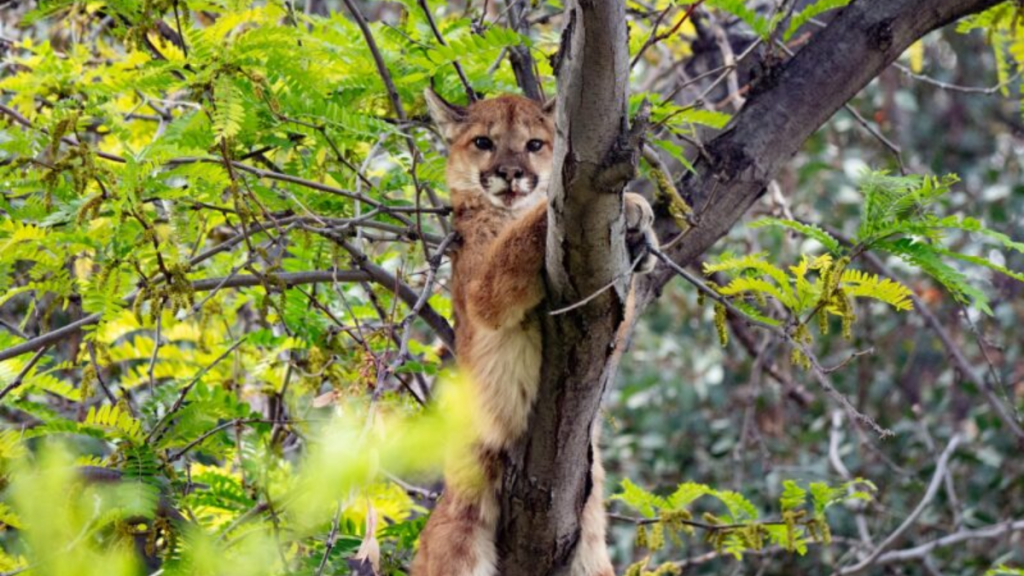Residents of a quiet suburban neighborhood were startled earlier this week when a mountain lion was spotted perched in a tree just yards from several homes. Wildlife officials were quickly dispatched to the scene to assess the situation and ensure public safety.
According to the State Department of Fish and Wildlife, the animal was first seen around 7:00 a.m. by a homeowner walking their dog. The large cat, later identified as an adult mountain lion, had climbed roughly 20 feet up a tree and remained there for several hours.
Local authorities, including animal control and police, arrived shortly after receiving multiple 911 calls.
Authorities Urge Caution
Wildlife officials monitored the mountain lion from a safe distance while keeping residents out of the immediate area. “Our main priority is to protect both the public and the animal,” said Officer Jennifer Carlson from the Department of Fish and Wildlife.
“These sightings are rare, but they do happen when natural habitats are nearby or disturbed.”
The mountain lion appeared calm but alert. Officials chose not to tranquilize the animal immediately, instead giving it time to descend and return to its natural territory. After approximately five hours, the mountain lion climbed down and disappeared into a nearby wooded ravine without incident.
Why Mountain Lions Wander Into Suburbs
Wildlife biologists say urban sightings of mountain lions are increasing due to ongoing habitat loss, food scarcity, and expanding residential developments. Mountain lions are highly territorial and solitary animals, and they sometimes travel long distances in search of food or mates.
“This is a reminder that we live close to nature,” said biologist Dr. Karen Ellis from the National Park Service. “Encounters like this are usually not aggressive, but residents should always take precautions.”
According to the U.S. Forest Service, mountain lions typically avoid human contact. However, they may enter residential areas if drawn by the presence of prey such as deer or small domestic animals.
Safety Guidelines for Residents
Following the sighting, the Department of Fish and Wildlife released a list of safety tips for those living near wooded or mountainous areas:
- Do not approach or corner a mountain lion. If encountered, maintain eye contact, make noise, and appear larger by raising your arms.
- Keep pets indoors, especially from dusk until dawn, when mountain lions are most active.
- Remove potential food sources like pet food, bird seed, and fallen fruit from yards.
- Install motion-sensor lights and secure livestock in enclosures.
The department also encouraged residents to report all sightings to local wildlife officials. Tracking these animals helps authorities better understand migration patterns and avoid future conflicts.
No Injuries Reported
No injuries were reported during the incident, and wildlife authorities praised the residents for quickly alerting authorities and maintaining a safe distance. “Situations like this can escalate if people try to get too close or attempt to take photos,” said Officer Carlson. “Let the professionals handle it.”
Nearby schools were briefly placed on lockdown out of an abundance of caution. The lockdown was lifted once officials confirmed the animal had left the area.

Long-Term Solutions and Coexistence
Local environmental groups are using the incident to call for more proactive measures to protect wildlife and educate the public about coexistence. Suggestions include building wildlife corridors to connect fragmented habitats and increasing public awareness programs in suburban areas.
“Encounters like this highlight the need for better planning in areas where human development intersects with wildlife habitats,” said Rachel Mendes of the Urban Wildlife Coalition.
“It’s not just about protecting people—it’s also about preserving the natural behavior and safety of these animals.”
Authorities stressed that mountain lion attacks on humans are extremely rare. Over the past 100 years, fewer than two dozen verified attacks have occurred in North America.
What to Do If You See a Mountain Lion
The Department of Fish and Wildlife recommends the following actions:
- Stay calm and back away slowly
- Never run, as it may trigger a chase instinct
- Pick up small children and pets immediately
- If the lion acts aggressively, throw rocks or yell loudly
- Report the sighting to local wildlife officials
If a mountain lion poses an immediate threat, call 911 or contact your local wildlife agency. For non-emergency sightings, most state wildlife departments provide online reporting tools.
For more information on mountain lions and safety procedures, visit the U.S. Fish and Wildlife Service or your state’s wildlife agency website.
Disclaimer – Our team has carefully fact-checked this article to make sure it’s accurate and free from any misinformation. We’re dedicated to keeping our content honest and reliable for our readers.
